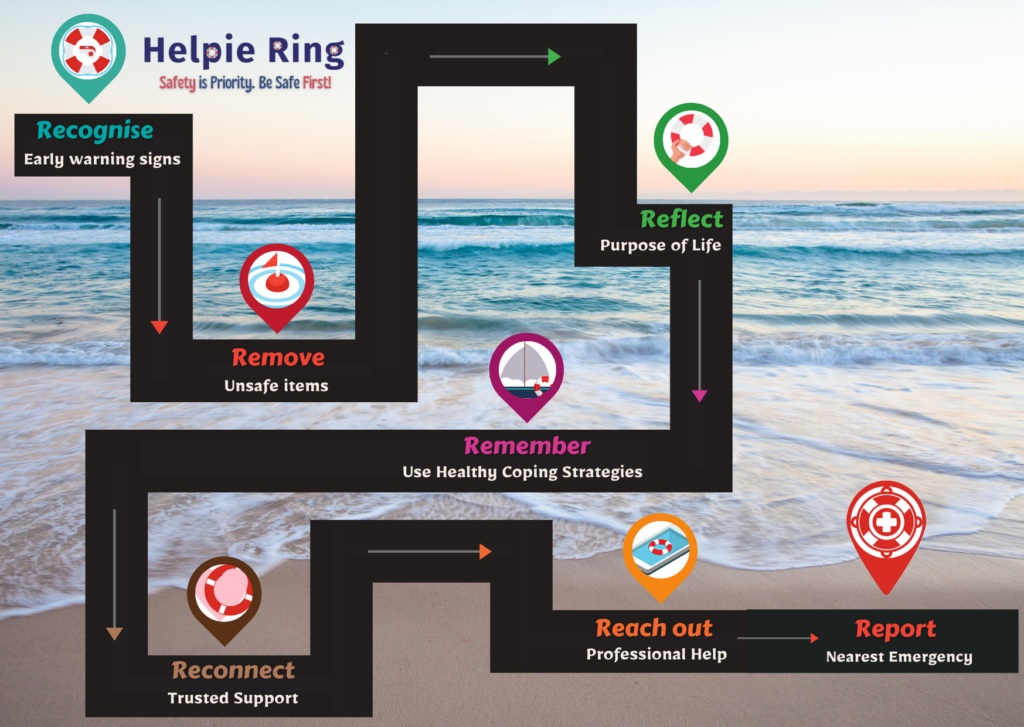A suicidal crisis refers to “a suicide attempt or an incident in which an emotionally distraught person seriously considers or plans to imminently attempt to take his or her own life” (Ref: Suicide Prevention Resource Centre – Topics and Terms). It can be distressing to go through suicidal thoughts, especially if they don’t seem to go away and interfere with your day-to-day life.
A safety plan is a document that supports and guides you when you are experiencing thoughts of suicide, to help you avoid a state of intense suicidal crisis. At the peak of the crisis, you can feel hopeless and may be unable to think clearly. It is at times like these that the safety plan becomes a valuable and handy tool, that draws on your existing strengths and support. Making a safety plan does not mean that something terrible will happen; instead, it a plan of action that makes you prepared to handle distress during the crisis. Safety plans implemented any time before the crisis are one of the best strategies to mitigate potential suicidal behaviours. Here is a “Seven Step Safety Plan to Stay Safe during a Suicidal Crisis”
Let us go through the steps of making your personalized safety plan:
Step 1 – Recognise your early warning signs
Step 2 – Remove unsafe items from your environment
Step 3 – Reflect on your purpose of life
Step 4 – Remember to use your healthy coping strategies
Step 5 – Reconnect with those you trust for support
Step 6 – Reach out to seek professional help
Step 7 – Report to your nearest emergency
- First, recognise your early warning signs – These include situations, thoughts & feelings, sensations, actions of you being distraught. These are your “triggers”. A trigger can take physical, mental or emotional form and causes you to react in a certain way. Here is an example. There is a situation of handling an intense embarrassing moment. You think you cannot face it and feel helpless & hopeless. You sense an intense urge to avoid seeing your family and friends. You skip your meals, are unable to sleep and avoid going out. As you isolate yourself, you feel lonely and depressed. Now, becoming aware of your warning signs can let you know you are getting mentally unwell. You may be at high risk of thinking about suicide when these triggers occur. These signs should warn you to set your plan into action and get you to the next step of keeping yourself safe.
- Second, remove hazardous items from your environment – You have thoughts of suicide or difficulty controlling your impulses. Then it is good to proactively keep your environment safe from harmful means like guns, ropes, pills, poisonous substances, sharp objects etc. Remove these items from your environment, put them away till you tide over the crisis, thus making it difficult for you to access.
- Third, reflect on your purpose of life – Your purpose of living keeps you motivated to survive. What gives you joy? What is the single most crucial thing worth living? What could be your reasons for living? When you are having thoughts of suicide, you can refer to your reasons for living to remind yourself of the positive aspects of your life.
- Fourth, remember to use your healthy coping strategies. Your unique healthy coping strategies are the activities you can undertake to keep your mind off the discomforting and scary suicidal thoughts. It can include physical activities like a brisk walk or jog if you have some energy. Or else focus on relaxation techniques like deep breathing and comforting tasks like making a meal or watching a light comedy. These activities can distract you from your active suicidal thoughts and help you get some energy back to handle the crisis with more clarity.
- Fifth, reconnect with those you trust for support. Your suicidal thoughts have become very intense for you to believe you cannot cope on your own. You can then think of the people like a trusted family member or friend you can reach out to for support. Distract yourself by going to public places like a park or place of worship where you can feel grounded. By moving to a more neutral or positive mental space, you can help your mind wander away from thoughts of suicide.
- Sixth, reach out to seek professional help – Note down the contact details and availability of professionals you’ve worked with who can help you in a crisis. Or any other immediately available professionals you should be able to reach out for professional help to manage your suicidal thoughts.
- Seventh, report to your nearest emergency – It can so happen that even after getting through all the above steps, you may still not feel safe.If your suicidal thoughts become intense; you should immediately call the nearest emergency you have noted or reach out to a crisis line.


